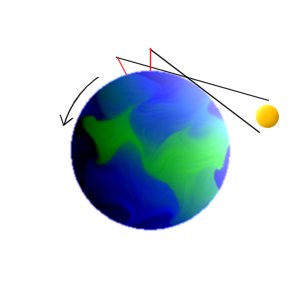  Here is a quick experiment, designed to show that the earth is round and to calculate its circumference. It is easy to do if you are in the right location. Unfortunately, in order to do this experiment properly you must have a clear view of the sunset or sunrise over the ocean. The idea behind the experiment is this: if the Earth is round, then objects which travel away from you along the surface of the Earth will disappear from view at a certain distance. More interesting is that they disappear from the bottom up. Think of a friend walking over a hill. If you watch her from one side of the hill as she walks over the hill, her feet will disappear first and then her legs and body followed by her head. This is one way ancient sailors knew that the Earth must be rounded like a hill. They could see the tall masts of ships long after their hulls as the boats receded far away. To see why this effect occurs, look at the diagram below:
As the Earth rotates, the view from the top of the pink stick changes to reveal the sun or make the sun disappear depending upon which way the Earth is rotating. If the Earth rotates as shown the Sun will disappear. (Note: this diagram is NOT to scale.) Looking at the following diagram you can see that if you watched the sunset from a low point of view and then got up really quickly you might be able to witness the sunset twice in one day.
Based on this principle it is possible to calculate the circumference of the Earth: Materials:
Directions:
h1 and h2= the height of your eyes during the two measurements (h1 should be the bigger of the two heights) s=the number of seconds between sun sets S=the number of seconds in one day, which is equal to 60 seconds*60 minutes*24 hours. This equation is a proportion that assumes the Earth rotates once in 24 hours so that the difference between the distances to the horizon over the whole circumference of the Earth is equal to the ratio of the time between your measurements and a whole day.
![{[60sec * 60 min * 24 hours
*
sqrt(2) * (sqrt(h1) - sqrt(h2))^2]/[6sec * 2pi]}^2 = Radius of the Earth](RADEeq.jpg)
 Back | Next |


![[sqrt(2Rh1) - sqrt(2Rh2)]/[2pi * R] = s/S](ratioeq.gif) , Where R = The radius of the Earth
, Where R = The radius of the Earth